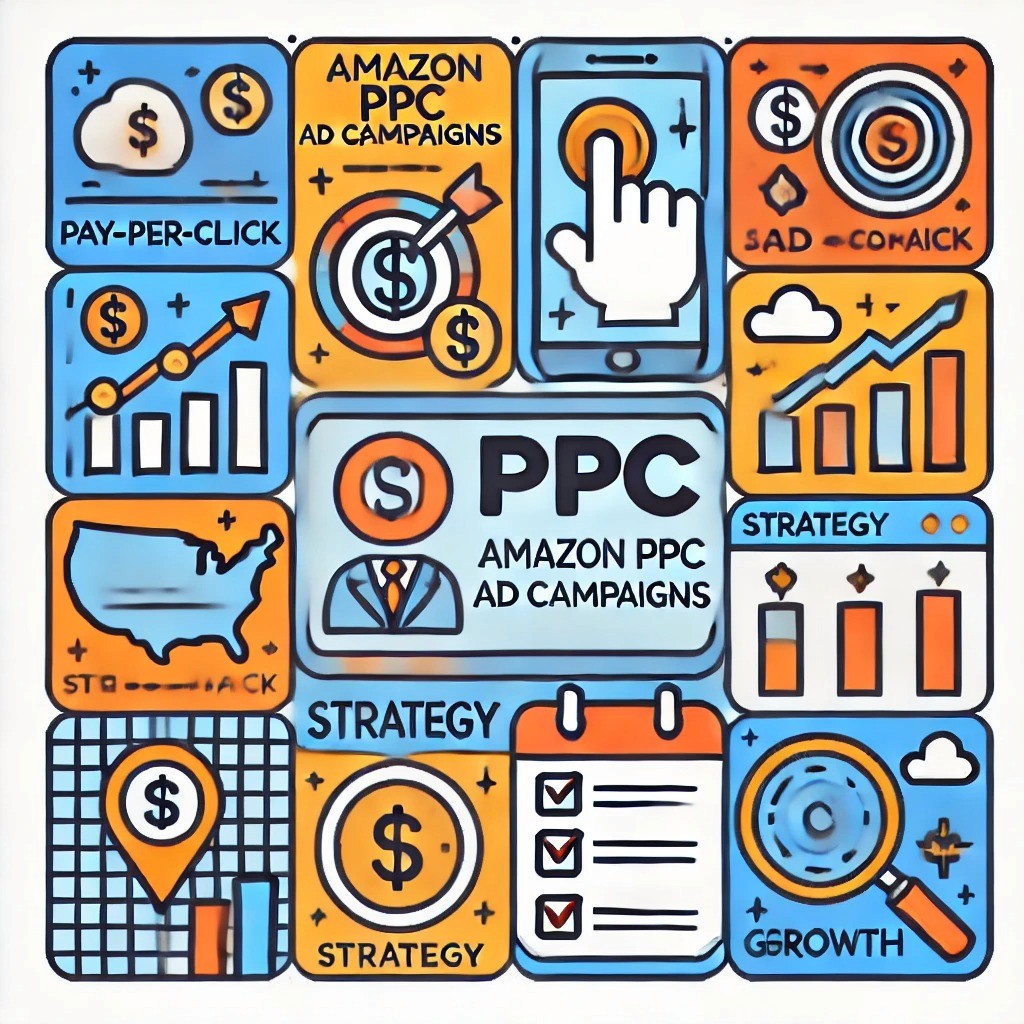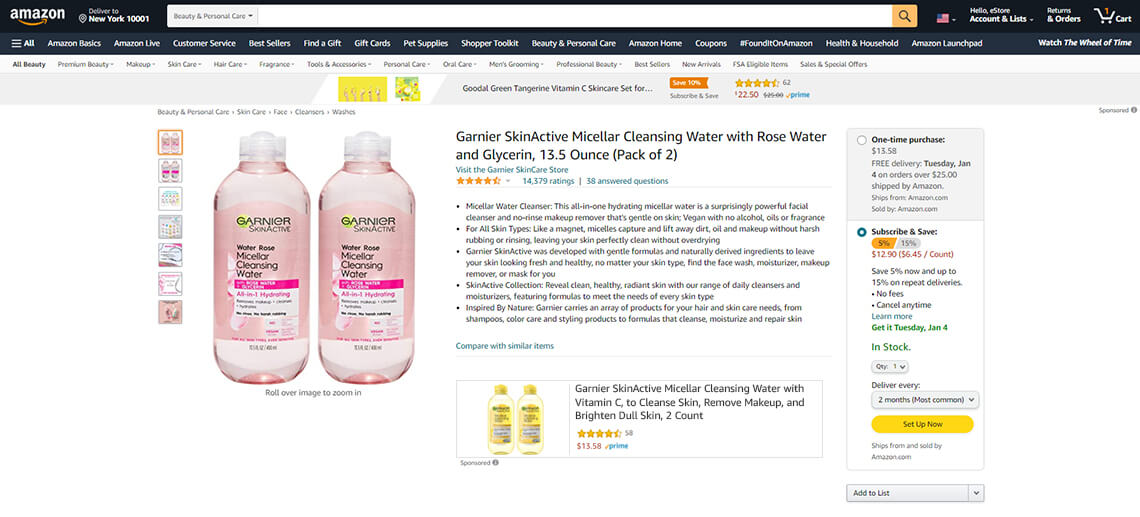Back to Page
Amazon PPC
9 Amazon PPC Ad Campaigns For A Robust Advertising Strategy
9 Amazon PPC Ad Campaigns For A Robust Advertising Strategy


Back to Page
Amazon PPC
9 Amazon PPC Ad Campaigns For A Robust Advertising Strategy

Jan 12, 2022
About 90% of the Amazon sellers we work with create PPC campaigns without setting a goal first. You cannot throw in a bunch of keywords, set bids, and hope for the campaigns to work. The keywords you add, the bids you set, the budget you allot – everything depends on your campaign objective. Whether or not a campaign is successful is also highly subjective. If your goal is brand awareness, you might not be bothered by the increased ACOS; all you care about is the visibility and reach of your campaigns. This quick guide provides you with an overview of the types of Amazon Sponsored Ad campaigns you can create based on your objective. Let’s get started.
#1: Research campaign

These campaigns work great to uncover new keywords and search terms shoppers are using to find your product. These campaigns help you stay up-to-date with the latest in trend keywords as Amazon’s algorithm and buying behavior evolve. Your research campaign should typically be automatic so you can download search term keywords every week and get your hands on profitable keywords that Amazon thinks perform well for you.
#2: Money making campaign

As the name suggests, these campaigns will be your most profitable campaigns as they’ll house your top-performing products and their top converting keywords. Investing in these types of campaigns can help you increase your organic ranking for a specific keyword.
#3: Competitor targeting campaign

These campaigns should include keywords that contain your competitor’s brand name. For example, if you are selling Nike shoes, the keywords you should target are “Adidas shoes,” “Reebok shoes,” etc. Make sure the product you’re selling is priced lower than your competitors to give customers a reason to choose you over your competitors.
#4: Brand protection campaign

These campaigns are set up to protect your market share and refrain anyone from making a sale using your brand name. Advertisers can build brand protection campaigns after they see momentum in sales and an increase in organic ranking. Brand protection campaigns will include all the products from your brand and all the keywords that contain your brand name.
#5: Protective targeting campaign

These are your typical product targeting campaigns, but you leverage them to target your own ASINs. This keeps your competitors from stealing shoppers off your listing. Using these campaigns, you can make the most of the real estate available on the product detail page and even give shoppers a chance to view another product from your catalog.
#6: Seasonal push campaign

Create and launch these campaigns to promote seasonal products. Run these campaigns before the festival/holiday to target shoppers when they are in a seasonal buying mode. Sponsored Brand ad campaigns work best because you can use an image and custom tagline to lure the shoppers in. Use seasonal push campaigns before Valentine’s Day, Mother’s Day, Father’s Day, Halloween, Back to school and other holidays. Seasonal campaigns can also be used to sell out the remaining stock of seasonal products.
#7: Product launch campaign

PPC plays a crucial role in spreading awareness of a just-launched product. These campaigns help you overcome the problem of not ranking in the early days of product launch. For product launch campaigns, you’ll want to bid more aggressively. Remember, in the initial days; you should be ready to operate at break-even point and even accept high ACOS. Leverage product targeting and show your ads on the detail page of one of your popular products. Showing ads on detail pages of your popular products can serve two purposes: (1) Your newly launched product will catch the eye of customers who are already interested in your brand and (2) if the product you are targeting has a good amount of reviews, it will serve as social proof for the new product.
#8: Brand awareness campaign

In this campaign, all your efforts should be focused on building or strengthening the awareness of your brand. Large and medium-sized brands should regularly implement brand awareness campaigns to maintain brand recall. Advertisers can leverage new-to-brand metrics to identify if their campaigns are reaching new customers or not. Brand awareness campaigns should target highly competitive keywords and have high bids. The only goal of brand awareness campaigns should be to increase the visibility and reach of your ads.
#9: Retargeting campaigns

Rather than trying to attract new visitors who may or may not convert, use Sponsored Ads Display campaigns to retarget repeat visitors who are more likely to convert. These ads appear on the product detail page or third-party websites and apps, depending on the targeting option you choose. With Sponsored Display Ads, you can retarget customers who’ve previously visited your detail page, target customers based on their interests and shopping behaviors, or target competing products and categories. Although Sponsored Display Ads were launched in 2019, only 25% of third-party sellers use it, making them one of the most underrated and underutilized ads.
How to create an effective Amazon PPC strategy
Step 1: Decide on your campaign objective. Each of your campaigns can have different objectives. A few of them can be targeted towards improving brand awareness, while some of them can be focused on simply improving your sales.
Step 2: Depending on your campaign objective, perform detailed keyword research. For brand awareness campaigns, your keywords should be related to your brand, and for product launch campaigns, you’ll need comprehensive keyword research consisting of the most common terms customers use to find your product.
Step 3: Select the campaign type, again based on your campaign objective. If retargeting is your objective, choose Sponsored Display ad campaigns and if brand awareness is your objective, choose Sponsored Brand campaigns.
Step 4: Set, bid and budget, add keywords and let the campaign run for at least a week before making any adjustments.
Step 5: Use ad reports to make tweaks in your campaigns. Continue reviewing and making adjustments in your campaign till you get the results you aimed for.
That’s all for today
Before deciding on your strategy, be sure to work on your campaign objectives and then plan on the tactics to achieve those objectives. Without fixating on what you’re trying to achieve, you cannot create campaigns based on assumptions. Include one or more of these campaigns in your strategy and see the difference in your KPIs from week 1. Schedule a meeting with your PPC consultant or get help from one of the Top Amazon PPC Agencies to help you get started with campaign creation and optimization.
About 90% of the Amazon sellers we work with create PPC campaigns without setting a goal first. You cannot throw in a bunch of keywords, set bids, and hope for the campaigns to work. The keywords you add, the bids you set, the budget you allot – everything depends on your campaign objective. Whether or not a campaign is successful is also highly subjective. If your goal is brand awareness, you might not be bothered by the increased ACOS; all you care about is the visibility and reach of your campaigns. This quick guide provides you with an overview of the types of Amazon Sponsored Ad campaigns you can create based on your objective. Let’s get started.
#1: Research campaign

These campaigns work great to uncover new keywords and search terms shoppers are using to find your product. These campaigns help you stay up-to-date with the latest in trend keywords as Amazon’s algorithm and buying behavior evolve. Your research campaign should typically be automatic so you can download search term keywords every week and get your hands on profitable keywords that Amazon thinks perform well for you.
#2: Money making campaign

As the name suggests, these campaigns will be your most profitable campaigns as they’ll house your top-performing products and their top converting keywords. Investing in these types of campaigns can help you increase your organic ranking for a specific keyword.
#3: Competitor targeting campaign

These campaigns should include keywords that contain your competitor’s brand name. For example, if you are selling Nike shoes, the keywords you should target are “Adidas shoes,” “Reebok shoes,” etc. Make sure the product you’re selling is priced lower than your competitors to give customers a reason to choose you over your competitors.
#4: Brand protection campaign

These campaigns are set up to protect your market share and refrain anyone from making a sale using your brand name. Advertisers can build brand protection campaigns after they see momentum in sales and an increase in organic ranking. Brand protection campaigns will include all the products from your brand and all the keywords that contain your brand name.
#5: Protective targeting campaign

These are your typical product targeting campaigns, but you leverage them to target your own ASINs. This keeps your competitors from stealing shoppers off your listing. Using these campaigns, you can make the most of the real estate available on the product detail page and even give shoppers a chance to view another product from your catalog.
#6: Seasonal push campaign

Create and launch these campaigns to promote seasonal products. Run these campaigns before the festival/holiday to target shoppers when they are in a seasonal buying mode. Sponsored Brand ad campaigns work best because you can use an image and custom tagline to lure the shoppers in. Use seasonal push campaigns before Valentine’s Day, Mother’s Day, Father’s Day, Halloween, Back to school and other holidays. Seasonal campaigns can also be used to sell out the remaining stock of seasonal products.
#7: Product launch campaign

PPC plays a crucial role in spreading awareness of a just-launched product. These campaigns help you overcome the problem of not ranking in the early days of product launch. For product launch campaigns, you’ll want to bid more aggressively. Remember, in the initial days; you should be ready to operate at break-even point and even accept high ACOS. Leverage product targeting and show your ads on the detail page of one of your popular products. Showing ads on detail pages of your popular products can serve two purposes: (1) Your newly launched product will catch the eye of customers who are already interested in your brand and (2) if the product you are targeting has a good amount of reviews, it will serve as social proof for the new product.
#8: Brand awareness campaign

In this campaign, all your efforts should be focused on building or strengthening the awareness of your brand. Large and medium-sized brands should regularly implement brand awareness campaigns to maintain brand recall. Advertisers can leverage new-to-brand metrics to identify if their campaigns are reaching new customers or not. Brand awareness campaigns should target highly competitive keywords and have high bids. The only goal of brand awareness campaigns should be to increase the visibility and reach of your ads.
#9: Retargeting campaigns

Rather than trying to attract new visitors who may or may not convert, use Sponsored Ads Display campaigns to retarget repeat visitors who are more likely to convert. These ads appear on the product detail page or third-party websites and apps, depending on the targeting option you choose. With Sponsored Display Ads, you can retarget customers who’ve previously visited your detail page, target customers based on their interests and shopping behaviors, or target competing products and categories. Although Sponsored Display Ads were launched in 2019, only 25% of third-party sellers use it, making them one of the most underrated and underutilized ads.
How to create an effective Amazon PPC strategy
Step 1: Decide on your campaign objective. Each of your campaigns can have different objectives. A few of them can be targeted towards improving brand awareness, while some of them can be focused on simply improving your sales.
Step 2: Depending on your campaign objective, perform detailed keyword research. For brand awareness campaigns, your keywords should be related to your brand, and for product launch campaigns, you’ll need comprehensive keyword research consisting of the most common terms customers use to find your product.
Step 3: Select the campaign type, again based on your campaign objective. If retargeting is your objective, choose Sponsored Display ad campaigns and if brand awareness is your objective, choose Sponsored Brand campaigns.
Step 4: Set, bid and budget, add keywords and let the campaign run for at least a week before making any adjustments.
Step 5: Use ad reports to make tweaks in your campaigns. Continue reviewing and making adjustments in your campaign till you get the results you aimed for.
That’s all for today
Before deciding on your strategy, be sure to work on your campaign objectives and then plan on the tactics to achieve those objectives. Without fixating on what you’re trying to achieve, you cannot create campaigns based on assumptions. Include one or more of these campaigns in your strategy and see the difference in your KPIs from week 1. Schedule a meeting with your PPC consultant or get help from one of the Top Amazon PPC Agencies to help you get started with campaign creation and optimization.
About 90% of the Amazon sellers we work with create PPC campaigns without setting a goal first. You cannot throw in a bunch of keywords, set bids, and hope for the campaigns to work. The keywords you add, the bids you set, the budget you allot – everything depends on your campaign objective. Whether or not a campaign is successful is also highly subjective. If your goal is brand awareness, you might not be bothered by the increased ACOS; all you care about is the visibility and reach of your campaigns. This quick guide provides you with an overview of the types of Amazon Sponsored Ad campaigns you can create based on your objective. Let’s get started.
#1: Research campaign

These campaigns work great to uncover new keywords and search terms shoppers are using to find your product. These campaigns help you stay up-to-date with the latest in trend keywords as Amazon’s algorithm and buying behavior evolve. Your research campaign should typically be automatic so you can download search term keywords every week and get your hands on profitable keywords that Amazon thinks perform well for you.
#2: Money making campaign

As the name suggests, these campaigns will be your most profitable campaigns as they’ll house your top-performing products and their top converting keywords. Investing in these types of campaigns can help you increase your organic ranking for a specific keyword.
#3: Competitor targeting campaign

These campaigns should include keywords that contain your competitor’s brand name. For example, if you are selling Nike shoes, the keywords you should target are “Adidas shoes,” “Reebok shoes,” etc. Make sure the product you’re selling is priced lower than your competitors to give customers a reason to choose you over your competitors.
#4: Brand protection campaign

These campaigns are set up to protect your market share and refrain anyone from making a sale using your brand name. Advertisers can build brand protection campaigns after they see momentum in sales and an increase in organic ranking. Brand protection campaigns will include all the products from your brand and all the keywords that contain your brand name.
#5: Protective targeting campaign

These are your typical product targeting campaigns, but you leverage them to target your own ASINs. This keeps your competitors from stealing shoppers off your listing. Using these campaigns, you can make the most of the real estate available on the product detail page and even give shoppers a chance to view another product from your catalog.
#6: Seasonal push campaign

Create and launch these campaigns to promote seasonal products. Run these campaigns before the festival/holiday to target shoppers when they are in a seasonal buying mode. Sponsored Brand ad campaigns work best because you can use an image and custom tagline to lure the shoppers in. Use seasonal push campaigns before Valentine’s Day, Mother’s Day, Father’s Day, Halloween, Back to school and other holidays. Seasonal campaigns can also be used to sell out the remaining stock of seasonal products.
#7: Product launch campaign

PPC plays a crucial role in spreading awareness of a just-launched product. These campaigns help you overcome the problem of not ranking in the early days of product launch. For product launch campaigns, you’ll want to bid more aggressively. Remember, in the initial days; you should be ready to operate at break-even point and even accept high ACOS. Leverage product targeting and show your ads on the detail page of one of your popular products. Showing ads on detail pages of your popular products can serve two purposes: (1) Your newly launched product will catch the eye of customers who are already interested in your brand and (2) if the product you are targeting has a good amount of reviews, it will serve as social proof for the new product.
#8: Brand awareness campaign

In this campaign, all your efforts should be focused on building or strengthening the awareness of your brand. Large and medium-sized brands should regularly implement brand awareness campaigns to maintain brand recall. Advertisers can leverage new-to-brand metrics to identify if their campaigns are reaching new customers or not. Brand awareness campaigns should target highly competitive keywords and have high bids. The only goal of brand awareness campaigns should be to increase the visibility and reach of your ads.
#9: Retargeting campaigns

Rather than trying to attract new visitors who may or may not convert, use Sponsored Ads Display campaigns to retarget repeat visitors who are more likely to convert. These ads appear on the product detail page or third-party websites and apps, depending on the targeting option you choose. With Sponsored Display Ads, you can retarget customers who’ve previously visited your detail page, target customers based on their interests and shopping behaviors, or target competing products and categories. Although Sponsored Display Ads were launched in 2019, only 25% of third-party sellers use it, making them one of the most underrated and underutilized ads.
How to create an effective Amazon PPC strategy
Step 1: Decide on your campaign objective. Each of your campaigns can have different objectives. A few of them can be targeted towards improving brand awareness, while some of them can be focused on simply improving your sales.
Step 2: Depending on your campaign objective, perform detailed keyword research. For brand awareness campaigns, your keywords should be related to your brand, and for product launch campaigns, you’ll need comprehensive keyword research consisting of the most common terms customers use to find your product.
Step 3: Select the campaign type, again based on your campaign objective. If retargeting is your objective, choose Sponsored Display ad campaigns and if brand awareness is your objective, choose Sponsored Brand campaigns.
Step 4: Set, bid and budget, add keywords and let the campaign run for at least a week before making any adjustments.
Step 5: Use ad reports to make tweaks in your campaigns. Continue reviewing and making adjustments in your campaign till you get the results you aimed for.
That’s all for today
Before deciding on your strategy, be sure to work on your campaign objectives and then plan on the tactics to achieve those objectives. Without fixating on what you’re trying to achieve, you cannot create campaigns based on assumptions. Include one or more of these campaigns in your strategy and see the difference in your KPIs from week 1. Schedule a meeting with your PPC consultant or get help from one of the Top Amazon PPC Agencies to help you get started with campaign creation and optimization.









